#infrared radar
Text


It's annoying that these are the most commonly used images of Venus because neither one is remotely what the planet actually looks like to the human eye. The one on the left is a radar image of the terrain below the cloud cover and the one on the right is an infrared view with greatly exaggerated colours. In actual reality the planet looks like an almost featureless white disk. The photo below was made by the MESSENGER probe on its way to Mercury and it's the most accurate to visible light close-up view of Venus we have.

14K notes
·
View notes
Text
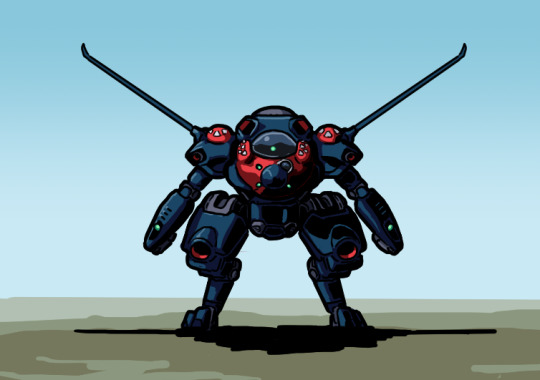
Wasn't *quite* happy with the initial fairy design so I've been iterating on it a little, this is what I've settled with at the moment, making the Choke launchers and arm lasers more clearly visible, and adding a little asymmetry with the IRST on the nose.
Choke is an abbreviation of Chaff-smoke, and is a vital tool on the battlefield. Normally released via high pressure grenades, Choke is made up of superheated smoke - which baffles visual and infrared sensors - and highly reflective crystal fragments, which do double duty of confusing radar and diffracting most energy beams which pass through. Inside Choke, short-range focused lasers and ballistics are king, but even then, they must be fired with little to no guidance.
183 notes
·
View notes
Text
"Beneath 1,350 square miles of dense jungle in northern Guatemala, scientists have discovered 417 cities that date back to circa 1000 B.C. and that are connected by nearly 110 miles of “superhighways” — a network of what researchers called “the first freeway system in the world.”
Scientist say this extensive road-and-city network, along with sophisticated ceremonial complexes, hydraulic systems and agricultural infrastructure, suggests that the ancient Maya civilization, which stretched through what is now Central America, was far more advanced than previously thought.
Mapping the area since 2015 using lidar technology — an advanced type of radar that reveals things hidden by dense vegetation and the tree canopy — researchers have found what they say is evidence of a well-organized economic, political and social system operating some two millennia ago.
The discovery is sparking a rethinking of the accepted idea that the people of the mid- to late-Preclassic Maya civilization (1000 B.C. to A.D. 250) would have been only hunter-gatherers, “roving bands of nomads, planting corn,” says Richard Hansen, the lead author of a study about the finding that was published in January and an affiliate research professor of archaeology at the University of Idaho.
“We now know that the Preclassic period was one of extraordinary complexity and architectural sophistication, with some of the largest buildings in world history being constructed during this time,” says Hansen, president of the Foundation for Anthropological Research and Environmental Studies, a nonprofit scientific research institution that focuses on ancient Maya history.
These findings in the El Mirador jungle region are a “game changer” in thinking about the history of the Americas, Hansen said. The lidar findings have unveiled “a whole volume of human history that we’ve never known” because of the scarcity of artifacts from that period, which were probably buried by later construction by the Maya and then covered by jungle.
Lidar, which stands for light detection and ranging, works via an aerial transmitter that bounces millions of infrared laser pulses off the ground, essentially sketching 3D images of structures hidden by the jungle. It has become a vital tool for archaeologists who previously relied on hand-drawings of where they estimated areas of note might be and, by the late 1980s, the first 3D maps.
When scientists digitally removed ceiba and sapodilla trees that cloak the area, the lidar images revealed ancient dams, reservoirs, pyramids and ball courts. El Mirador has long been considered the “cradle of the Maya civilization,” but the proof of a complex society already being in place circa 1000 B.C. suggests “a whole volume of human history that we’ve never known before,” the study says."
-via The Washington Post, via MSN, because Washington Post links don't work on tumblr for some godawful reason. May 20, 2023.
#maya#mayan#mesoamerica#central america#el mirador#guatemala#indigenous#indigenous history#indigenous peoples#mesoamerican#architecture#ancient history#anti colonialism#fuck racist misconceptions and narratives about indigenous societies and technologies#history#good news#hope
251 notes
·
View notes
Text
Spaceway 70 - Pablo
The Marlin heaves out of the darkened dock, whining with unwarmed engines. A simple objective:
- Assess damages, neutralize threats.
I've done it a million times before. Come to think of it,—
Red lights blare outside and the station's distress call is picked up by the radio. I fly around the cylindrical body—perform a systematic scan. How would the incident report be written?
- Upper hull damaged in a hit-and-run bombing; station status unknown.
- Soldier casualties: ...
Soldiers. They never chose to lay down their lives—to fight for an uncaring ruler—not them.
- Assailant(s): Unknown vessel, presumed solitary. Heat signature detected, actively pursuing.
Ambiguous language. Open to litigation. Sarge would be sad.
- Disregard previous entry. Chasing assailant via engine heat; infrared reading with 0.87 certainty. Monitoring radar.
- Radar confirms a small ship. Moving at 75% of own velocity. Distance 2000 mi.
-
-
- 1500.
-
-
- Approaching civilian zone
-
-
- 1000.
-
-
- 500.
-
- 250.
-
- 175.
-
- 100.
- 50.
- 25.
- Contact.
They pull up and to the left, attempting to get above and behind me, though it's too little, too late.
- Assailant neutralized with ballistics. Assumed to have hit engine.
- Upon visual examination, there appears to have been no pilot. Control is either automated or remote. No outstanding radio frequency detected.
Darn...
Out and ahead of me are markers indicating a commercial route. Safe for traders.
A transponder on one of the markers pings my ship. Something about remaining in place, a unit arriving soon. I don't make it a good hundred miles before a squad comes in with weapons hot.
I dodge a few shots and they graze me with a laser. I'm not about to make war with a whole task force.
The Marlin is a ship of esoteric construction. It has a hull constructed for incredibly heavy salvos—granted you have enough sealant [1] aboard. It comes with a cloak [2], more a scrambler than anything, which uses up insane amounts of power, and an EM pulse [3] which likewise drains my batteries. It's a perfect ship for an early retirement [4], as long as my encounters are few and far between.
With the push of a fader I turn my radio into a tool of war, creating a streak of white along their IR imager and making their radar unusable. Similarly, with a press of a button the magnetron pulses on, disabling their steering and warming up their cabins.
- Three combatants neutralized; nonlethal means
Two more pull down and in front, shooting and missing. I pull up and turn around, hoping to hit them with more microwaves.
< -#- VACDETEC V1.4 -#- >
< ALARM >
<HULL BREACH | d.0s>
<HULL BREACH | d.1s>
<HULL BREACH | d.2s>
I begin to sweat as the laser weapon dissipates as heat into my cockpit.
< HULL SEALED >
< SEALANT AT 25% >
I need to leave.
I reach up to grab a solar compass [5] and scribble my heading onto the cockpit glass.
- Taking extratactical measures: Magnetron shielding angle set to 175.8 degrees
< ## Are you sure? Use of EMP with current settings may cause systems to misbehave. ## >
[ YES ]
Navigation goes dark as two more ships behind me lose steering. I launch a wide-range RF jammer [6] and a hot net [7]. I cut my engines and seal the exhaust [8].
This is a special dance they taught us in Academy; " . . . each ship has its own precise limits, though with them come potential," they had us memorize old literature, "that is why you must know yours more intimately than the body of your lover . . . " I positioned one hand over the exhaust control and another over the ignition. Two seconds, three seconds, and
< -#- SHELL -#- >
< ALARM >
<ENGINE OVERHEAT>
The ship rattles as I rocket dead ahead in the direction of home. Another alarm blares on my monitor,
<CHECK ENGINE>
A few milliseconds too late. I hear a faint whisper—a hiss—join the chorus of the Marlin's song. I'm sorry. I'll fix it soon. It'll be ok.
" . . . for each time you take up the helm, you partake in a romance far more real than any other, for no other can see the terror
of a deprivation so terrible, or a death so swift."
[1]: A chemical formulation which undergoes an extremely exothermic reaction when exposed to the vacuum of space. Akin to tire sealant from when vulcanized rubber was used for land vehicles.
[2]: A system consisting of telescoping antennae and an ultra-high amplitude RF generator. Hides a ship's exact location within a much broader, irregular radio signature.
[3]: A high-powered magnetron capable of producing strong microwaves with multiple miles of range. Temporarily scrambles navigation systems, causing affected ships to veer off-course.
[4]: I can't keep doing this
[5]: An indicator which points in the direction of the closest star, when properly calibrated. Detects the unique products of nuclear fusion.
[6]: Akin to the cloak, a disposable projectile which blanks out vast swathes of a ship's radio imager.
[7]: A large, mechanized retroreflector which concentrates heat from all directions, and shoots it back at the viewer, making infrared imaging of a ship nearly impossible.
[8]: In reference to a mechanism which seals the exhaust vents of the Marlin. This turns the entirety of the engine tract into a bomb. A stupid idea if held closed for more than a few seconds.
39 notes
·
View notes
Text



The XB-70 Valkyrie was an extremely large airframe; the YF-12 was not small being 107 feet long. But if you compared the two, the Blackbird looked small.
The Mach 3 rivalry between the YF-12 and the XB-70.
North American Rockwell made the first Mach 3 bomber (Although the six-engine Valkyrie could only dash to Mach 3 due to aero heating and not cruising at that speed).
Their public relations firm was advertising every place they could about how their airplane could fly higher and faster than anyone could before.
On the other side of Edwards Air Force Base (AFB), the YF-12 Blackbird kept its secrets near and dear. The YF-12 was a variant of the A-12 with a backseat for the missile launch controller.
The YF-12s took the seventh through ninth slots on the A-12 assembly line; these were designated as YF-12A high-altitude, Mach 3 interceptor. The main changes involved modifying the A-12’s nose by cutting back the chines to accommodate the huge Hughes AN/ASG-18 fire-control radar initially developed for the XF-108 with two infrared search and track sensors embedded in the chine leading edge, and the addition of the second cockpit for a crew member to operate the fire control radar for the air-to-air missile system. This airframe could easily fly Mach 3.
As told by Donn A. Byrnes and Kenneth D. Hurley in their book Blackbird Rising: Birth of an Aviation Legend, they were both being tested at Edwards AFB at the same time, so naturally, they hung out at the same bar after work. One of the local watering holes was called Hernandez Hideaway.
YF-12 test pilots, often flew at Mach 3 more often than the XB-70 would do in a lifetime.
Jim Eastham had just about enough of the bragging he heard daily about the XB-70. Eastham was a Lockheed test pilot who had already flown the A-12 and was now flying the YF-12. One evening at the bar Al White of the XB-70 program was raving about his high Mach numbers when Eastham couldn’t stand it any longer. He turned to White and said, “Al, we do more Mach 3 time in a single YF-12 mission than you guys have flown in your entire program” Al looked at Jim, and without missing a beat, he said, “yes that’s true, Jim, but we lose pieces that are bigger than what you fly!!
The XB-70 was an extremely large airframe; the YF-12 was not small being 107 feet long. But if you compared the two, the Blackbird looked small.
Written by Linda Sheffield
Originally published an aviation geek club
@Habubrats71 via X
40 notes
·
View notes
Text
Some things in ASOIAF are just meant to seem vastly powerful and outright unfair. See: dragons, which basically outplay any other kind of warfare.
Stannis’ shadow assassin is meant to (seem, at first) unprecedented and overpowerful. It’s a moment where this guy wins, even though he has a smaller army, he has less popular support, even though he has cut ties to basic cultural foundations like religion and is facing ridiculous odds by making no allies among other “rebels.”
Instead, Stannis wins because he’s taken a crazy gamble to the idea that magic is real, it can be used for warfare, and it will be used as a tool, regardless of what the Maesters say. The shadow baby reveal is supposed to be this moment where you say “oh shit, this guy is straight up playing a different game than the rest of these lords.”
And then, that in turn sets you up to think Stannis is totally going to own at the Blackwater, because you saw him just use totally overpowered tactics, and then in a surprise twist he doesn’t win, and then you think: wow, it really is Melisandre and her magic which are responsible for Stannis’ success.
And then you read the Mel chapter in Dance and you see that she’s faking half of it, and you wonder what the hell all of these powers really are.
And then you go: wow, what a cool and mysterious series where people have very unequal circumstances and similarly unequal capabilities at their disposal, what a complex web of military and social dynamics this has become by inserting crazy new magical features into political action.
And then you go: wow, I wonder if this is what it felt when they invented steel weapons or suits of armor or longbows or greek fire or RADAR or air combat or covert ops or infrared cameras or tanks or drones or napalm or stealth jets or nuclear bombs etc etc etc
38 notes
·
View notes
Text
Venus Is Not Nekkid
aka what does Venus really look like?
Ok so you've probably seen pics of Venus like:

which is amazing 1990s radar data from NASA's Magellan spacecraft that discovered its surprisingly young, almost crater-free surface and fissures and lava flows and shield volcanoes:

Which was a vast improvement, because apart from 6 photos of the surface by Russian landers asking "why me?", all we had before were grainy Mariner & Pioneer images from the 1970s showing Venus wrapped in featureless clouds in visible light or striped in ultraviolet:


Magellan's radar peered through the clouds to reveal a surface less than 500,000 years old. Without plate tectonics to release heat, hotspots ooze continually, resurfacing the planet in a way that may resemble primitive Earth before plate tectonics.
More terrifyingly, Venus may have been habitable for billions of years until it had a massive flood lava catastrophe like the Earth at the end of the Permian, when 95% of life on our planet died. Except on Venus it was even worse, setting off a runaway greenhouse effect that boiled away the oceans.
Most solar system "family portraits" show Venus with Magellan's false-color radar data, naked, stripped of her thick blanket of clouds:

US "Views of Our Planets" stamps (Mercury also false color, Jupiter & Uranus UV I think)
But that's not how Venus looks through a backyard telescope. She's a shining white pearl, which was why the Greeks & Romans recognized her as Aphrodite/Venus.
In 2020, JPL engineer Kevin M Gill reconstructed a visible-spectrum portrait of Venus from old 1974 Mariner 10 probe data using UV and other odd wavelengths:

See this writeup on the image with a discussion of Venus' crazy clouds racing around the planet like a toxic hurricane.
A whole community of astronomers and image wizards has grown up hunting through old missions for data they can crunch and de-noise with data processing tools to create new, better images. Space agencies have taken note and now post data for them to play with.
So when 2015 Japan's dogged Akatsuki spacecraft finally made it to Venus after several mishaps, we got its first [UV images]:

Then they started posting raw data from all their instruments (UV and near-IR, because a white pearl is pretty but not as useful for science) and the image wizards went to work.

[two UV images combined by Damia Bouic]
Citizen scientist Damia Bouic has a whole blog post of gorgeous Venus images she's processed from Akatsuki data: Here's just a few. They're false color to bring out details, but I think (?) she's using the visible-spectrum colors of Venus for the color and the UV and/or IR data for saturation and brightness.
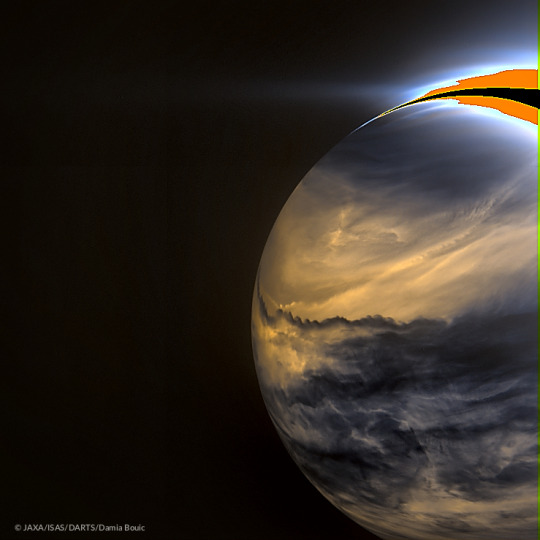
Venus' night side in infrared (detects heat). Check out that funky wave. clouds at the equator move the fastest, but I'm not sure what's causing that.

Another UV image processed by Damia Bouic
TL;DR: Venus is Beauty in visible light, the Beast on the surface, and I guess you'd call UV/IR views "I have a bad feeling about this."
130 notes
·
View notes
Text
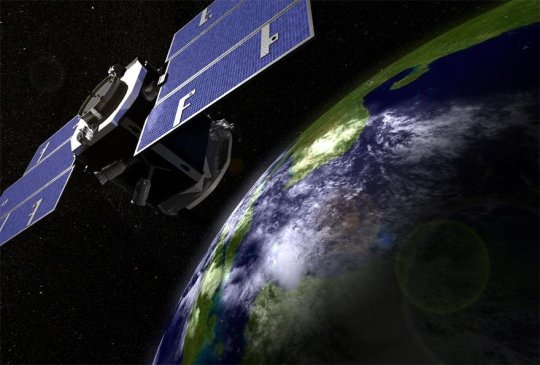
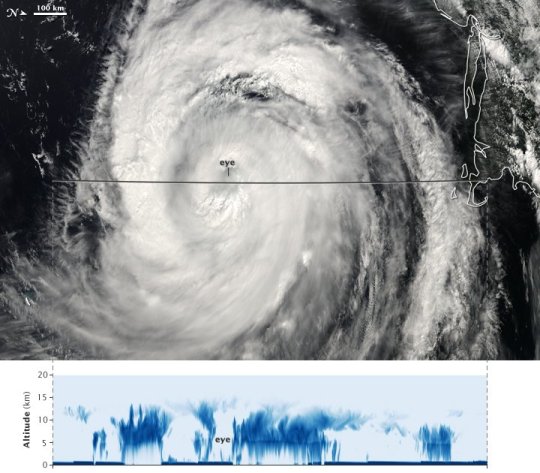
NASA’s CloudSat Ends Mission Peering Into the Heart of Clouds
Over the course of nearly two decades, its powerful radar provided never-before-seen details of clouds and helped advance global weather and climate predictions.
CloudSat, a NASA mission that peered into hurricanes, tallied global snowfall rates, and achieved other weather and climate firsts, has ended its operations. Originally proposed as a 22-month mission, the spacecraft was recently decommissioned after almost 18 years observing the vertical structure and ice/water content of clouds.
As planned, the spacecraft — having reached the end of its lifespan and no longer able to make regular observations — was lowered into an orbit last month that will result in its eventual disintegration in the atmosphere.
When launched in 2006, the mission’s Cloud Profiling Radar was the first-ever 94 GHz wavelength (W-band) radar to fly in space. A thousand times more sensitive than typical ground-based weather radars, it yielded a new vision of clouds — not as flat images on a screen but as 3D slices of atmosphere bristling with ice and rain.
For the first time, scientists could observe clouds and precipitation together, said Graeme Stephens, the mission’s principal investigator at NASA’s Jet Propulsion Laboratory in Southern California. “Without clouds, humans wouldn’t exist, because they provide the freshwater that life as we know it requires,” he said. “We sometimes refer to them as clever little devils because of their confounding properties. Clouds have been an enigma in terms of predicting climate change.”
Clouds have long held many secrets. Before CloudSat, we didn’t know how often clouds produce rain and snow on a global basis. Since its launch, we’ve also come a long way in understanding how clouds are able to cool and heat the atmosphere and surface, as well as how they can cause aircraft icing.
CloudSat data has informed thousands of research publications and continues to help scientists make key discoveries, including how much ice and water clouds contain globally and how, by trapping heat in the atmosphere, clouds accelerate the melting of ice in Greenland and at the poles.
Weathering the Storm
Over the years, CloudSat flew over powerful storm systems with names like Maria, Harvey, and Sandy, peeking beneath their swirling canopies of cirrus clouds. Its Cloud Profiling Radar excelled at penetrating cloud layers to help scientists explore how and why tropical cyclones intensify.
Across the life of CloudSat, several potentially mission-ending issues occurred related to the spacecraft’s battery and to the reaction wheels used to control the satellite’s orientation. The CloudSat team developed unique solutions, including “hibernating” the spacecraft during nondaylight portions of each orbit to conserve power, and orienting it with fewer reaction wheels. Their solutions allowed operations to continue until the Cloud Profiling Radar was permanently turned off in December 2023.
“It’s part of who we are as a NASA family that we have dedicated and talented teams that can do things that have never before been done,” said Deborah Vane, CloudSat’s project manager at JPL. “We recovered from these anomalies with techniques that no one has ever used before.”
Sister Satellites
CloudSat was launched on April 28, 2006, in tandem with a lidar-carrying satellite called CALIPSO (short for the Cloud-Aerosol Lidar and Infrared Pathfinder Satellite Observation). The two spacecraft joined an international constellation of weather- and climate-tracking satellites in Earth orbit.
Radar and lidar are considered “active” sensors because they direct beams of energy at Earth — radio waves in the case of CloudSat and laser light in the case of CALIPSO — and measure how the beams reflect off the clouds and fine particles (aerosols) in the atmosphere. Other orbiting science instruments use “passive” sensors that measure reflected sunlight or radiation emitted from Earth or clouds.
Orbiting less than a minute apart, CloudSat and CALIPSO circled the globe in Sun-synchronous orbits from the North to the South Pole, crossing the equator in the early afternoon and after midnight every day. Their overlapping radar-lidar footprint cut through the vertical structure of the atmosphere to study thin and thick clouds, as well as the layers of airborne particles such as dust, sea salt, ash, and soot that can influence cloud formation.
The influence of aerosols on clouds remains a key question for global warming projections. To explore this and other questions, the recently launched PACE satellite and future missions in NASA’s Earth System Observatory will build upon CloudSat’s and CALIPSO’s legacies for a new generation.
“Earth in 2030 will be different than Earth in 2000,” Stephens said. “The world has changed, and the climate has changed. Continuing these measurements will give us new insights into changing weather patterns.”
More About the Missions
The CloudSat Project is managed for NASA by JPL. JPL developed the Cloud Profiling Radar instrument with important hardware contributions from the Canadian Space Agency. Colorado State University provides science data processing and distribution. BAE Systems of Broomfield, Colorado, designed and built the spacecraft. The U.S. Space Force and U.S. Department of Energy contributed resources. U.S. and international universities and research centers support the mission science team. Caltech in Pasadena, California, manages JPL for NASA.
CALIPSO, which was a joint mission between NASA and the French space agency, CNES (Centre National d’Études Spatiales), ended its mission in August 2023.
TOP IMAGE....An artist’s concept shows NASA’s CloudSat spacecraft in orbit above Earth. Launched in 2006, it provided the first global survey of cloud properties before being decommissioned in March 2024 at the end of its lifespan. Credit: NASA/JPL
LOWER IMAGE....NASA’s CloudSat passed over Hurricane Bill near the U.S. East Coast in August 2009, capturing data from the Category 4 storm’s eye. This pair of images shows a view from the agency’s Aqua satellite (top) along with the vertical structure of the clouds measured by CloudSat’s radar (bottom). Credit: Jesse Allen, NASA Earth Observatory
12 notes
·
View notes
Photo

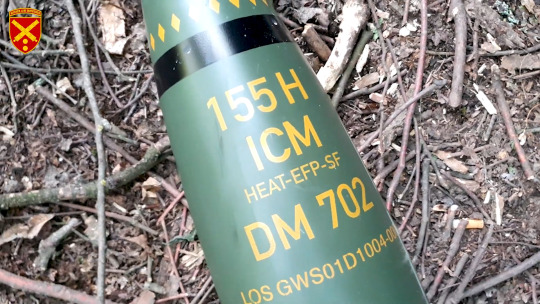
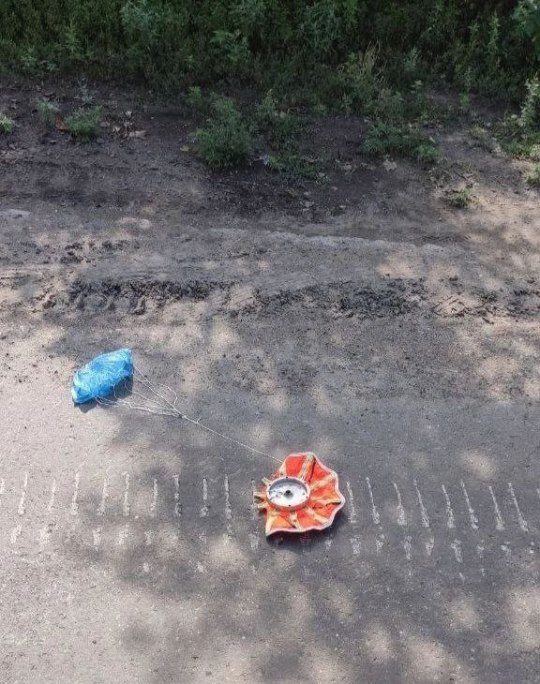

Top Attack SMArt 155 In Ukraine
A look at the German SMArt 155, a Sensor Fuzed Munition, currently in use in Ukraine. It releases a pair of fire-and-forget top-attack submunitions. The submunitions use a ballute and parachute to slow their descent and allow the onboard infrared sensor and millimeter wave radar to locate its target and fire down an explosively formed penetrator.
youtube
Check out the accompanying article for this video here.
#SMArt 155#Artillery#War in Ukraine#Ukraine War#PzH2000#Military#Military History#History#155mm Howitzer
59 notes
·
View notes
Note
Palmer AU when there’s a serious storm, though. Ava being all, “momma earth, call it off, I wanna go out and play,” and Suzanne is just, “no.” The storm is knocking out everybody’s special fancy equipment so Beatrice is, “I’m going to take a nap. Would you like to join me Ava?” and Ava’s brain melts so she just nods emphatically and drags Beatrice to Beatrice’s quarters. Lilith first checks all her aquariums, then has to search for Camila. Suzanne helps her out so she doesn’t disturb avatrice and says Camila is probably in the ‘boiler room,” a small space full of machines loud enough to drown out a storm. Camila sits wrapped in her favorite blanket with a mug of tea. “Everyone says I’m crazy, but it is warmer in here,” Camila says in greeting. “Everyone says I’m crazy, but it’s usually about diving in places they wouldn’t want to dive.” “Is there anywhere you wouldn’t want to dive?” “… maybe the Hudson?” “Eww, yeah. Good call. Anyway, I like to wait out storms here. Wanna cuddle?”
beatrice is 100% the guy who has at least a dozen tracks on her phone that are like ‘10 hours of [insert extreme weather here]’ so she greets the prospect of a huge storm by carrying a load of blankets up to her observatory and stocking the mini-fridge ava got her with snacks.
ava: bea… you want to sit in a room that’s 64% glass while the sky tries to eat us??
beatrice: 😐 of course i do. how many times in my life will i have the chance to observe an arctic storm?
ava follows her up there, footsteps tentative on the metal steps, still making a racket in her hobnail boots. drawn by the prospect of lazy sex under a ripped-up sky and staying for the way beatrice holds her hand the whole time, as they wend up through the building with the wind already sighing at them through the thickness of the walls.
bea at first wrapped in her ragged blue blanket with threadbare, tasseled edges. her comfiest hoodie and a space heater running off solar batteries.
noticing that ava’s a little spooked and telling her in her soothing lecture monotone about the exact composition of the glass windows; all the reasons why they won’t break.
‘mechanically, breakage is about the propagation of cracks, on an atomic level, then into our visual range. thinner cracks are usually worse, if you’re the thing that’s breaking.’
(and ava doesn’t tell her that she knows about breaking, actually. that’s she done it).
‘but this glass doesn’t let it happen in the profuse way of the glass you’re used to. it’s stable, probably sturdier than the walls.’
the sea turning dark as the clouds scatter over the horizon, bea explaining how storms work, research papers she’s read about the atmosphere on venus and what Sagan said about the runaway greenhouse effect, everything trapped beneath the sulfuric clouds that make it so difficult to even look at the planet's surface.
‘what must that have felt like? to be denied the image of a distant place even though you could peer right towards it.’
‘you see then how light can illuminate, but also obscure. how the universe has so much light in it, but that can make it hard to see what sits behind the light, beyond it.'
'do you know how we discovered the dark parts of the universe? how we learned about them? through their absence in the visual field.’
she talks about the development of radar and infrared, and when the storm hits ava’s just draped against her, lost in the curve of her voice and her waist because she’s stuck her cold hands under bea’s hoodie. lazily pressing her mouth into bea’s neck to feel the hum of her low voice as vibration.
ava: i think i get it now
bea: what?
ava: how you can know a place, or a person, even without any light.
#palmer station au#meanwhile lil & cam are in the basement & cam's saying 'i like to be close to the machines. they're like my family.'#& lilith saying in her blunt and totally unaffected way. 'no. i'm your family.'#storms are gay you heard it here first#anon i LOVE where your head is at with this
53 notes
·
View notes
Text
You know what, fuck y'all *yeets Murder Drones AU into your dash*
Ima copy paste the blurb I once posted in a Murder Drones subreddit. Price Series is the name of MD!Poli btw...at least his current one.
Brought to you by Price Series (yep, that's his name...blame his parents)
"If you are familiar with Worker Drones, Copper-9, Disassembly Drones, and something about a core exploding, then I don't need to educate you on that side of history. But if you need to and you're living under a rock...no offense...then I'll summarize it.
"We are worker drones: robots used to mine exoplanets and be humanity's pets and workers, mostly for JCJenson IN SPAAAAACE! (TM). But when the core of Copper-9, our exoplanet, exploded...well...only we drones are left, plus robotic pets, plus perfectly intact houses...you get the point. We build our own homes here, made our own families, and find love! No, Mister Wilson, there is no such thing as human zombies. The temperature is too frozen for their bodies to move on their own. Now sit down, please.
"The Disassembly Drones (we found out about their names via an interview with someone we capture...trust me, we'll get to that one later) appeared because our parent company hates the concept of free will. We fell into a dark age where we live in fear of them...until someone came to save us all.
"His name is our great founder Ricky, Ricky Julius. This bastard is a genius, using his laser guns and snow-friendly boots to chase off the disassembly drones and bring peace to our town once again. This is where the golden age of technology and safety ensued.
"He set up a program—along with most other things like politics, building security departments like what we're inside right now, and more—and this program is special. It was like the human military where every boy drone wants to get in, because this program gives them augmentations and alterations to their body parts, making them effective Murder Drone Murderers and Worker Drone Rescuers: Resistance Drones.
"Resistance Drones is a special type of drone, as you can see in our slideshow (Sorry I didn't actually show its visualization). Besides their cylindrical arm structure, detachable tails that can change length, and a special target-locking program, they have the ability to detect things from far away using radars, detach their body parts—yes, even the head—have acid-immune metal parts and acid-secreting claws and mouth, and have a cloaking program that can be used for shapeshifting. Their main weaknesses are said cloaking being detected via infrared, their lack of flight, and their lack of regeneration. Still, their acid and body detaching helped with taking down Disassembly Drones. Ever since then, we have killed off eight of those murderers, with two from separate squads retreating somewhere.
"But unexpectedly, they rebelled. Something about someone sneaking in some sort of virus in them while they're on shutdown. After the Golden Age came the Second Dark Age after a few years, to say. Lead by a vicious Resistance Serial"Ar", also known as Arson, our town almost fell into his iron fist. But like what happened to the first dark ages, someone stepped up like Ricky did...except that she did something different.
"Her name is Orpah Loid, and she has "special" programming that can make her manipulate things to her liking. The rescue drones were intimidated by her like how the murder drones were by Ricky...except that this time, they hid and they made sure that they won't show themselves to Cluster-4, this place we thrive in, except for some rare scenarios. After this, she never appeared, leaving her two sons at the mercy of an adoption center—yes, her eldest was formerly a girl, deal with it...now you're becoming creepy! Sit down, Miss Chair, or else I'll call your dad!
"Now today, we're pretty much in a state like the Golden Age, albeit with stricter security, more idiots running in the departments, and lesser threats despite the absence of the significant thing that made the Golden Age iconic...if not controversial...
"Yeah...let's continue on: THE WEAPONS CONVENTION!"
---
As Price left the room and the newbies to their own devices until the one actually handling them comes, greeting some passerby drone as he walked pass by the metallic but welcoming interior of the organized mess of a hallway. He then see a drone with dark red hair tucked under his large ushanka, waving at him with his apple red eyes showing impression. "Goddamn that's some good lecture you got there, Poli."
Price sighed as he said, "I told you to not call me 'Poli' over a stupid joke that befallen me ages ago, Rhode!"
"Hey, that was a funny joke!" Rhode interjected.
"Was your processor fried again?!"
"Hey!"
Both laughed as Rhode approached price and messed with his synthetic, royal blue hair. If drones can smell, the odor of hair dye lingered in the area. "Look at you, rising up the ranks of the security department."
"Couldn't have said more, you know," Price smiled as he tucked his hands into his hoodie pockets. He removed one and touched the star-like badge on his left chest, its silver shade pairing up nicely with his baby blue outfit. "So, where do you want to dine in?"
"Maybe in that newly-opened battery restaurant?"
"Anything but a battery restaurant," Price groaned. "We have a kid at home and someone who will offended to see her friends get addicted to that stuff!"
"So what should we even eat? Nails? Screws? Oil?" Rhode made a disgusted face with that. "We ain't murder drones, dude."
"I've heard someone having a controversial but good-looking dish incorporating the oil of 'retired' cattledrones," Price declared. "And for some reason...I really want to try that..."
Rhode silently gasped as he saw Price's teeth briefly shift into sharper fangs before he decided to exclaim, "We're here in the importing sector now!" Rhode was glad that Price got distracted by his voice.
"And now we w-" Price dropped his jaw at the sight of what was being held in place at the center of the sector. It was a large crate as large as a car, and by the strain it was putting into the vehicle being used to keep it stable, it was damn heavy.
Price then felt some buzzing from his pockets and he checked it out to be from a number he knew. He smiled and answered, "Hey Amy! How's the kid doin' in our place?"
"Surprisingly great!" The voice of a female rang through. "He's still downcast from the fact that his brother is no longer...alive...but he is carrying it through."
"Ah. Alright, we're busy here. Bye."
Meanwhile, Amy looked with nervousness with the way Henry speedread through her books, two books all at once. She then shrugged and said to herself, "He's a genius."
On the other hand, Henry's eyes are locked onto various keywords, his visor glitching quite a bit.
#(in)security#robocar poli#robocar poli au#rcp-stuff#hmmm#murder drones#although there is no N here unfortunately...
11 notes
·
View notes
Text
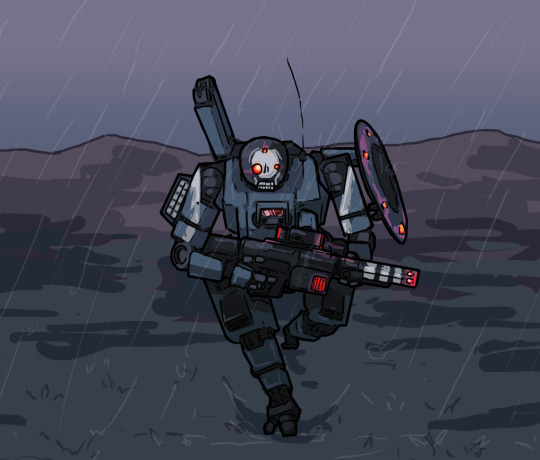
Customised variant of the Lohan-Scott 'Dope' Light Mech. Modifications tend towards making it easier to repair in-field and being more robust overall: The large head unit which contains a laser has been switched for a smaller, better armoured replacement, and the forward camera has been removed entirely, with an analogue periscope in its place.
Main armament is a 4-aperture converging laser rifle. For anti-armour combat, all four lasers fire simultaneously while for soft targets, they're instead ripple-fired to increase fire-rate. At the right shoulder sits a 2x5 grenade launcher loaded with 'Sink' munitions - air bursting grenades with a mixed payload of hot smoke and reflective strips, capable of confounding radar, visual and infrared sensors while also disrupting laser fire.
The left shoulder is fitted with a high-frequency deflector shield, capable of redirecting lower mass, supersonic projectiles - namely cannon rounds or anti-tank missiles. The energy draw of such a system is immense, so it can only be activated for short periods. Furthermore, it has limits with regards to especially high-energy impacts like railguns and is utterly useless against lower-speed kinetics like melee weapons.
197 notes
·
View notes
Note
Hi! 🙂 Enjoyed your game very much! Especially the cosmic horror scene in which the God mode MC wakes up 😄. I hope to see more how absurd and horrifying GM power can be from other POVs. Definitely one of my favorite WIPs.
So, I have a few questions and a few suggestions. I'll start with the questions.
I'll refer to the MC as him.
1) What the scope of Alexis' omniscience? In other replies you mentioned that she knows everything across all timelines. Do you mean it just in the context of TLs that MC with time powers can create or is she also aware of routes where MC has different powers? Or maybe she knows that MC can have other names, genders, and appearances? Or, taken to the extreme, she is even aware of the 4th wall? In which case, does she know that the MC is the protagonist?
2) You said that the God mode MC posesses some degree of omniscience. However, it doesn't seem very consistent, so I just wanted to clarify it's extent. For example the MC seems to sense the entire universe, immediately notices that the storm is alive, knows who Gaia and Elara are before meeting them, knows everything about the DA, and, when talking to Gaia, says that the only thing he doesn't know is what he is. However in other scenes he doesn't seem to be aware of things that happen in his direct vicinity, like when he doesn't notice that the pond is actually a guy, and can't instantly identify and locate Michael. So, what the God mode MC does and doesn't know?
3) You often refer to the MC, Alexis, Adam, and Ron as anomalies. What does it actually mean? Is it just that they have particularly strong abilities, or is there another, deeper meaning?
Now, to suggestions.
1) I think the God mode MC's personality should be somewhat different from MCs with other powers.
For example one personality can be apathetic and disconnected from humanity, kind of like Dr. Manhattan.
Another personality may be carefree and friendly, but somewhat lacking common sense, like genuinely not getting what is the big deal about dissipating the red storm with a single thought.
Another personality might be nonsensical and crazy, like Sheoggorath.
Yet another one might be proud and even arrogant like Gilgamesh from Fate.
But, regardless of personality type, in my opinion the God mode MC should almost never act surprised, confused, or puzzled, even when the player is. Unless something truly unexpected occurs, he should always have this "all according to keikaku" attitude.
2) I think telepathy and superintelligence should also to some extent affect the way MC acts and views others.
3) I've seen somebody suggest adding gravity control. But how about taking it a step further and adding the power to manipulate all 4 fundamental interactions? This would be a pretty versatile and powerful ability.
Basic uses of gravity manipulation would allow levitation, telekinesis, controlling mass of objects, repelling attacks and just collapsing enemies into meatballs or flattening them into pancakes. On the high end it could be used to create black holes or even wormholes.
EM manipulations at its most basic could be used to zap people, control metals, turn coins into railgun projectiles, etc. Also it would allow to manipulate EM spectrum, for example bend light to shoot lasers or turn invisible, have x-ray or infrared vision, see through walls, hear radio waves, emit gamma rays or act as a radar. Most precise level of control would allow modifying mechanical properties of materials, turning matter into antimatter by changing electic charge and desintegrating enemies by cancelling chemical bonds inside them.
Honestly it would be a pretty cool power just by itself, though MC would probably be a constant nuisance to Olivia by being a walking EMP device 😅
Weak force could be used to destroy things through nuclear decay or turn any object into a neutron bomb.
Strong force could be used to transform one element into another, split things into elementary particles, etc. The flashiest application though is the matter-to-energy conversion, which would allow to turn any mass into improvised nukes, for example a 50ml glass of water would yield a 1 megaton explosion.
The applications overlap though, as such both gravity and EM would enable some forms of flight, matter-antimatter annihilation functionally isn't any different from matter-to-energy conversion, etc.
4) When MC with telepathy and God mode hears phrases in other languages they should probably be translated. The superintelligent MC might also be able to at least pick up the meaning from the context.
5) It would be cool if MCs with telepathy, superintelligence and God mode could fry or overload the brains of hostile telepaths.
The first question would be answered in-depth with the next GM update.
It's pretty hard to explain the degree of the GM MC's partial omniscience, so I'll just put it this way, the MC is aware of almost anything, but has some blind spots at the moment due to them not being fully aware and accepting their entire situation.
This would change however, after the update and their meeting Alexis.
Firstly, you should really add MC's sister to be among the top of that list. Secondly, there is a deeper meaning, but it contains spoilers so I'll just let Pryon tell you themselves when your MC meets them.
Now for your suggestions:
I'm totally in line with your first suggestion.
The second suggestion is also something I agree with and have been trying to implement.
The third suggestion sounds super OP, I'll definitely note that down.
The fourth suggestion is already being implemented.
The last suggestion is something I also fall totally in line with.
Thanks a lot, really, I appreciate long feedback like this that takes a lot of time just to help point things out and point me in the right direction.
15 notes
·
View notes
Text


🇮🇷🇷🇺 🚨 🔥NEW SHAHED/GERANIUM DRONES DEVELOPED BY IRAN FOR RUSSIAN FORCES OPERATING IN UKRAINE🔥
Two new varieties of Shahed drones have been developed by Iran, which are expected to be used by Russian Forces operating in Ukraine.
According to the source:
A new variety “Geranium” has been developed for Ukraine
Iran has unveiled a new kamikaze drone, the Shahed-238, local media reported.
More precisely, there are three versions: with an inertial system and GPS (like the Shahed-136), with an infrared/optical guidance system (something like the Lancet), and on the left - with a radar homing head, which makes this model a nightmare for systems Air defense with radar.
The technical characteristics of the Shahed-238 have not been disclosed, but it is known that it is equipped with a jet engine. That is, it will fly faster, although perhaps closer.
#source
@WorkerSolidarityNews
#russo ukrainian war#russia ukraine war#russia ukraine conflict#russia ukraine today#special military operation#russia#iran#russia news#iran news#russian military#islamic revolutionary guard corps#irgc#news#war#war news#war update#wars#politics#geopolitics#world news#global news#international news#breaking news#current events#eurasia#eastern europe#military news#WorkerSolidarityNews#russia smo#smo
12 notes
·
View notes
Text

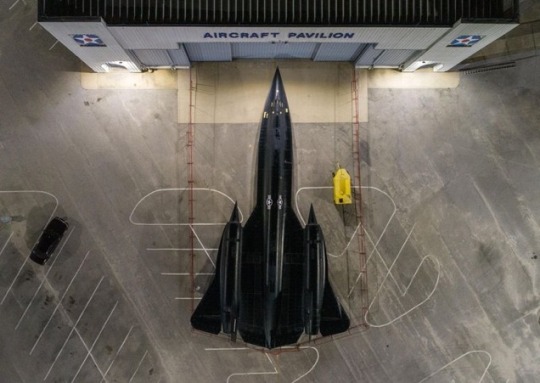

Why was the SR-71 Blackbird chosen over the A-12 Oxcart?
There was a flying competition how epic would it be to be able to witness a fly off between the A-12 and the SR 71!
The iconic SR-71 Blackbird spy plane is known for being the official record holder for the fastest jet-powered, piloted aircraft of all time.
The SR-71 was based on another Mach 3, high altitude reconnaissance aircraft, the A-12 Oxcart.
The A-12 was operated by CIA but its operational lifetime was short-lived because the CORONA reconnaissance satellite, which was first launched in June 1959, began providing worldwide imagery without much of the risk associated with airborne reconnaissance. At the same time, the SR-71 began operations with the US Air Force (USAF), leading to the A-12’s retirement in 1968.
Why was the SR-71 Blackbird chosen over the A-12 Oxcart?
From Oct. 20 to Nov. 3, 1967 the A-12 and the SR-71 were pitted against each other in a recon fly off, code named “Nice Girl” over the US that included refueling, flying identical routes 1 hour apart on three different days and both would complete the full sortie with collection sensors operational. On the first attempt, the SR-71 was OK but the A-12 had a problem. On the 2nd day, the reverse was the case. On day 3, both aircraft successfully flew the route. On that day, it was under-cast for the northern part (from California to Kentucky) and the A-12 could only photograph clouds while the SR-71 was able to collect ELINT and SLR data. After air refueling, both accelerated and climbed over the Gulf of Mexico. From New Orleans to the San Francisco area, the weather was CAVU and both aircraft were able to provide their full collection capability/data for the evaluation.
•Lt. Col. Al Hichew and I, Maj. Tom Schmittou flew mission #1.
•Maj. John Storrie and Maj. Coz Mallozzi flew mission #2 Maj.
•Bill Campbell and Capt. Al Pennington flew mission #3.
•Jack Weeks flew all three A-12 missions.
The first two flight days were inconclusive. After the third day of flights, it was determined by Intelligence evaluators that the SR-71 was a better overall investment. A-12s had much better cameras – wider swath and higher resolution but the SR-71 collected more types of intelligence than the CIA aircraft could. These other sensors were infrared detectors, side looking airborne radar, and ELINT-collection devices needed for the SR-71 mission of post-nuclear-strike reconnaissance.
The conclusion was they picked the SR-71 to continue flying. The A-12s were retired. The A-12s were put in hangars until 1984. (They might’ve been taken out and used again. Only the CIA knows the answer to that as it should be.)
Written by Linda Sheffield Miller this was shared in aviation geekclub, two years ago.
@Habubrats71 via X



36 notes
·
View notes
Text
Notes on gear in Campoestela, mostly spacesuits:
Spacesuits are cheap and widely produced compared to today, but they are also tailor-made, much like a VERY, very high-end business suit. Going to a spacesuit tailor is often expensive and a bit of a chore, as you have to tailor everything from the actual suit to atmospheric mixes, especially when it comes to different species. However, once they are done, they usually last for life.
The main kind of spacesuits are the "skintight" counter pressure suits (see here). They look remarkably like racing suits, and are rather easy to put it on and comfortable. Carbon nanotube and smart materials deal with most of the uncomfortable parts, but you WILL feel a certain Tingle in your more curvy parts. You've been warned.
You can, actually, wear your suit as everyday clothing. There's also zippers for when you have to go... The astronaut underwear, of course, still works as a diaper (dissolving *stuff* with genetically engineered bacteria for that purpose), and when missions get extensive, there's no other way. Because of the bad past reputation of astronauts who did it anywhere, they have gone all the other way now, and most spacers are meticulously clean and very touchy about that subject.
(the beforementioned bacteria, as well as atmospheric and pressure mixes, have to be customized for different species, which makes spacesuits a rather expensive lifetime investment)
Helmets are standarized, but by far, the most complex part of the suit. Equipped with radio, lights, a HUD controlled by eye movement and blinking (though many prefer wrist buttons), and even some little snacks and water in case you are stranded and have to wait hours or even days for rescue. They are very easy to put it on, seal automatically with the collars of all spacesuits, and unlike current ones, they allow you to move your neck inside.
(there's also a little stick to scratch your nose).
Astronauts love to put stickers on their helmets. In fact, spacesuits are very much personalized; a plain space white suit is frowned upon. Mission patches and flags, much like punk battle jackets, and very often the name is on big letters on the back, like a football jersey, for easier identification. Many spacers, especially those who like to stand out, go even further and decorate their suits with family heradly, or special artwork like tattoos, you can find some that look like an abstract or baroque painting and you can say "oh, it's This Guy" (and that's exactly the intention). Most of this of course applies to human spacer cultures, other cultures and species have different traditions. Some might look all the same, but in ultraviolet or infrared reveal all sorts of complex patterns.
Spacesuits backpacks are very much miniaturized, also easy to connect to standarized helmets. Helmets themselves have limited air recycling capabilities, but you need a backpack for any EVA.
LISTEN UP, ASTRONAUTS! Here's what you need to have in your belt before heading off: a beeper (radar to check distances from objects), backup radio, sealing patches (if there's any puncture on the suit or helmet), intravenous iodine (for radiation), sedants and anti-nausea (not a good idea to go out with nausea or The Bends in an emergency, species dependant of course), signal flares and flashlight, multiknife (or facón if you're Esteloplatense), and don't DARE going out without a safety line.
On a planet, suit or not (what, are you going out with your suit planetside? are you from a movie or something?) you still have some gear on your belt all the time. Breather mask and goggles just in case, again, a multitool or knife, pills with nutrients for when the local food isn't enough (for Argentines, they look like La Yapa candy), iodine pills, a kind of smartphone for rugged terrain (like two months of battery and capable of being sunk in mud with no problem), advanced wristwatch (many carry a mechanical one for emergencies) and various other tools. If your belt doesn't do a jingle jangle when you're walking, are you even an astronaut?
Bullet or energy weapons are frowned upon in spaceports, obviously. Most spacers have some 'on the trunk' for emergency, but unlike most science fiction, they don't usually go carrying them around all the time. In fact, gunfights in remote spaceports are mostly a fiction from the equivalent of western movies.
Most spaceships also carry a lot of little bots that do all the maintainance that biologicals can't do, especially since these are ATOMIC ROCKETS we are talking about, and a human fixing a nuclear lightbulb engine would get their DNA chopped. These droids are ubiquitous in all spaceship garages and cargo bays, and usually you can adopt one for cheap, they're treated much like pets and are very hardy; they do need a lot of radiation cleaning though.
14 notes
·
View notes